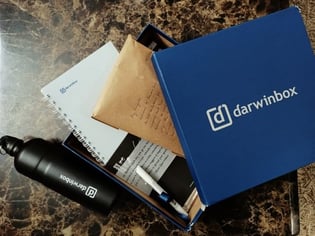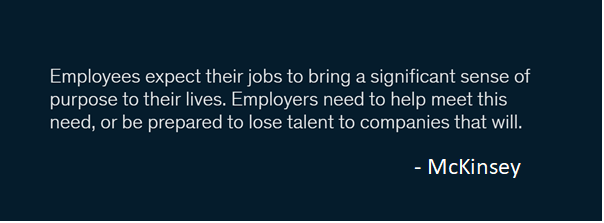

When organizational psychologist Anthony Klotz coined the phrase "the Great Resignation”, little did he know how ‘great’ of a wave it really would be.
According to the U.S. Bureau of Labor Statistics, 4 million Americans quit their jobs in July 2021. Resignations peaked in April and have remained abnormally high for the last several months, with a record-breaking 10.9 million open jobs at the end of July.
And that’s just the tip of the iceberg.
55% of people in the workforce said they are likely to look for a new job in the next 12 months, according to Bankrate’s August jobseeker survey.
A product of the Great Resignation myself, I understand where the need to quit the old and seek the new comes from. And where it seems to be headed.
If anything, the global pandemic helped us put things in perspective. It prodded us to ask ourselves questions we were afraid to ask before. It peeled off the layers that had masked our desires. It made us stare at our own truth – nakedly and with authenticity.
What followed were stories of employees taking the leap of faith into new careers. Following their passions. Seeking their dreams. Sometimes, without the cushion of another job.
But as diverse as the reasons for resigning, so are the expectations of employees from their new employers. While we don’t know what we don’t know, we now know what we need and how.
Below are some tried and tested ideas and solutions for talent management. Could these be the antidotes to the Great Resignation? Only time will tell.
Wellbeing as a part of the success metric
According to a 2020 HBR study, the lockdown has been positive for knowledge worker productivity in the short term.
That’s hardly surprising.
The sudden transition to work from home had us develop new ways of working and coping, almost overnight. Across the board, with 12% less time spent on large meetings, 50% more activities taken up through personal choice (and not because someone else asked us to do), time reduction on the commute, and, oftentimes, inability to maintain defined boundaries between work and life, higher than usual productivity was reported for the period between April to August 2020.
But too much of anything is rarely good. Or sustainable.
So, when the Best Workplaces™ saw a return to healthy productivity levels in December, it was officially time to bid goodbye to a remote work schedule that was costing us more than providing for it.
Being custodians of culture at a workplace, the HR function now shoulders the responsibility of ensuring that the employee’s health and wellbeing are uncompromised. Without a doubt, employee wellbeing should be central to all HR endeavors. Today, employee well-being has expanded beyond physical well-being to focus on building a culture of holistic well-being including physical, emotional, financial, social, career, community, and purpose.

Obsession with Employee Experience
I joined Darwinbox in the thick of the Great Resignation; July 12th, 2021, to be specific. My interviews, my onboarding – all happened virtually as I continued to work from the exact same spot of my home office.
Physically, nothing changed.
Emotionally, I had to unpack a lot from my previous employment of 10 years and forge new relationships through a device tethering me to the world. If it hadn’t been for an empathetic manager who welcomed me with a box of brand swag and a hot coffee to help me kickstart my new journey, I would have had just another day at work. But the little things, the small touches of personalization made a world of difference to setting the tone of my experience with a brand I had only known as an outsider until then.


With work and workplace showing no signs of slowing down in the areas of remote working and virtual collaboration, organizations need to rethink the way they engage talent in the new normal. Elements like connection, collaboration, social networking, and the entire gamut of employee engagement, rewards & recognition will be crucial both for employee experience (EX) and the optimization of business outcomes. You need to craft a winning experience in the hybrid workplace to mitigate the effects of the Great Resignation.
The empathy enterprise
We knew it all along, but pandemic held the spotlight on it long enough for everyone to acknowledge that employees are in the front and center of everything. For businesses to thrive and drive productivity, they need to move the needle on their talent management practices by being empathic to the needs of their workforce. It’s about creating a culture of free expression, holding the space for people to express their anxieties, fears, and concerns while giving them tools to learn, grow and exercise their power at all stages of the employee lifecycle. No empathy is true empathy if engagement is not embedded in the flow of work. So, enabling ways for employees to engage and stay connected with each other is just as important. Build the empathy enterprise with this toolkit.
Start with WHY
Simon Sinek’s contribution to the business world is massive. But his work on finding our why has been a standout by all standards. His practical guide for discovering purpose has prodded orgs and leaders to drill down into intrinsic motivations for self and others. In his words, “Everyone in an organization knows "WHAT" it is that they do. Some know "HOW" they do it. But very few know "WHY" they do what it is that they do.” But in the race to profitability (these days, the IPO run), companies are overseeing their workforce’s collective ‘why’. Not in malice, of course, but in the general course of things.

Nearly two-thirds of US-based employees said that COVID-19 has caused them to reflect on their purpose in life. People who live their purpose at work are more productive than people who don’t. They are also healthier, more resilient, and more likely to stay at the company. Moreover, when employees feel that their purpose is aligned with the organization’s purpose, the benefits expand to include stronger employee engagement, heightened loyalty, and a greater willingness to recommend the company to others. (source: McKinsey)
Creating a purpose-driven organization has never̥ been more critical than now. Especially when life-altering events, like the pandemic, have urged us to view life through a microscope – reexamining our existence and purpose (there’s the word again). An important point to remember is having a purpose for the sake of purpose won’t cut it. It needs to be woven into the very fabric of the company culture for the transformation to transpire.
The right ‘tool’kit
Any event that has a global impact across all spheres of life, permanently changes the landscape of work, play, and everything in between. Even as we continue adjusting and readjusting to the new normal, it is the technology that runs as the common narrative – connecting us to the BC (Before Covid-19). Today, more people work remotely than ever before, and even with covid vaccinations well on the way to completion, the trend doesn’t show any signs of dwindling down.
In May 2021, a Mercer study found that 70% of companies said they were planning to adopt the hybrid model. Many companies have already made the switch, including prominent brands such as Adobe, Salesforce, Spotify, and Twitter.
So as digital continues to be the enabler and driver of the Gig and (now) the Remote Economy, improvement to the tools we use in response to the changing world of work is a must-have. According to Blissfully’s 2020 Annual SaaS Trends report, the average mid-market business (101-999) employees use 185 different applications. The sheer number of tools and the sheer dependency on them to execute tasks necessitates not just a solid tech stack but training and upskilling too.
Consider these two stats: according to a study by Capgemini Consulting, only one in ten adults in the U.S. feel that they have sufficient computer and Internet skills to use the digital tools they’re responsible for in their daily work. In a research report released by Gartner in June of this year, it was found that employees with high digital dexterity were 3.3 times more likely to quickly and effectively execute digital initiatives in their organizations. It’s a no-brainer to assume how the opposite or lack of digital dexterity would play out in the business world.
So along with equipping the workforce with the right set of technology and tools, providing a toolkit in the form of upskilling programs, training - not just on the digital systems but also on mindset shifts – is a step in the right direction.
Growth all the way
Continuing with the above, one of the most staggering stats on employee growth came out in a 2019 Workplace Learning Report by LinkedIn which found that, if a company invests in employees’ careers, 94% of employees would stay at the company longer. However, only 29% of employees are "very satisfied" with their current career advancement opportunities available within their organization, as per an SHRM report. This indicates a gap that needs to be filled and now!
Prioritizing employee growth has never been more important than now where opportunities are on the rise and barriers to quitting are at an all-time low. So along with taking a skills-based approach for their workforce development, orgs need to mobilize job rotation programs, lateral/ horizontal movements, dual career ladders, job redesign, etc. to assist employees in their career progression within the organization.
“If you love someone, let them go, for if they return, they were always yours. And if they don’t, they never were.” - Khalil Gibran
If only these quotes applied to the business world, The Great Resignation would not have rocked the proverbial HR boat as it has today. But the truth is, employees and companies share a dynamic relationship. As dynamic, if not more, than any personal relationship we have with our family and friends. The non-linearity of it, owing to the subjective lenses of the employees and the employers, makes it a unique bond that’s both solid and fragile. This interesting duality necessitates the need to discover antidotes - some tactical, some strategic – that will help us convert The Great Resignation into The Great Retention.
About THE ONE THING
The One Thing is a monthly column by Pranjalee Lahri who sees life as a glass half full. As a mother, a wife, a manager, a marketer, and a handful of other roles she plays every day, her ability to tackle ‘the one thing’ that leads to a positive domino effect on other pressing matters has been her secret mantra for years. In this column, she uses the same principle to dissect ‘the one challenge, the one trend, the one objective’ with easy-to-use, everyday solutions.



Speak Your Mind